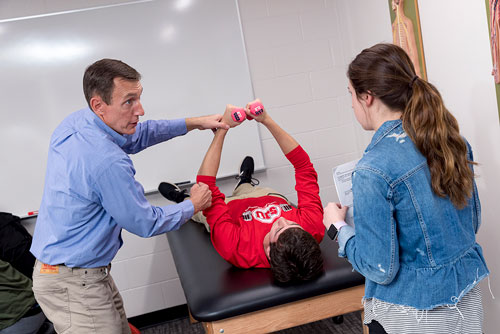New exercise and health science major to launch in fall 2020
February 11, 2020

EHS majors will gain classroom knowledge before getting the chance to apply it in real-world settings.
According to 2018 American College Testing (ACT) data, approximately 1.3 million students in the United States were interested in attending a four-year college/university, including 41,000 students in the state of Minnesota. Of those prospective students, approximately 20% indicated an intent to major in a “Health Science and Technologies” field. The next largest group of prospective students (14%) identified themselves as undecided on a major.
Health professions are an area of interest and growth, and the newest major at the College of Saint Benedict and Saint John’s University is designed to educate students interested in exercise and allied health fields. In fall 2020, CSB/SJU will implement the new exercise and health science major.
“We’re excited to partner with students in examining and understanding the human experience of sport, exercise and physical activity in an inclusive learning environment that fosters a culture of excellence and professionalism,” said Department Chair Don Fischer.
Exercise science is the study of why and how humans engage in and respond to physical activity, exercise and sport. The primary application of exercise science is to benefit human health, exercise or sports performance. This new exercise and health science major will emphasize health as an application of exercise science, while still retaining sport performance and coaching components.
Strengths of the new major
The exercise and health science major is designed to prepare students to enter the health and exercise fields as effective, ethical, client-centered professionals. The major will accomplish this by enabling students to:
- Gain a solid foundation in the sciences. With an emphasis in scientific theory and critical thinking, students will be ready to enter the workforce or make an easy transition to graduate school.
- Develop the habits of effective decision-making. Throughout the curriculum, students will develop evidence-based decision-making skills important in the practice of exercise science and health.
- Get real-world experience. Through both service-learning and internship opportunities, students will be able to apply classroom knowledge and skills in real-world settings while developing important professional skills.
- Engage in undergraduate research. Students will learn and practice research skills and have the opportunity to complete an undergraduate research project as the capstone to the major.
- Create a pathway to academic and professional success. Courses provide students the opportunity to learn about career options and develop a plan to be successful when they enter the workforce or transition to graduate school.
- Understand the diversity of the human experience. In conjunction with the new Integrations Curriculum, students will develop an understanding of and appreciation for cultures, genders and religious beliefs that will enable them to practice as a client-centered professional in the fields of exercise and health.
Where can graduates go?
Rising health care costs and an increasingly important focus on wellness and chronic disease prevention have increased the demand for the exercise science and preventive health workforce. The Bureau of Labor Statistics projects that the job outlook for fitness trainers and instructors will increase by 10% between 2016-2026 (faster than average) and by 16% for health educators and community health workers. Job growth for exercise physiologists will rise by 13% (much faster than average), athletic trainers by 23% (much faster than average) and physical therapists by 28% (much faster than average).
Current students may pursue this new degree. However, students interested in switching their major to exercise and health science should consult with an academic adviser to determine whether the switch will affect their ability to graduate in four years.
